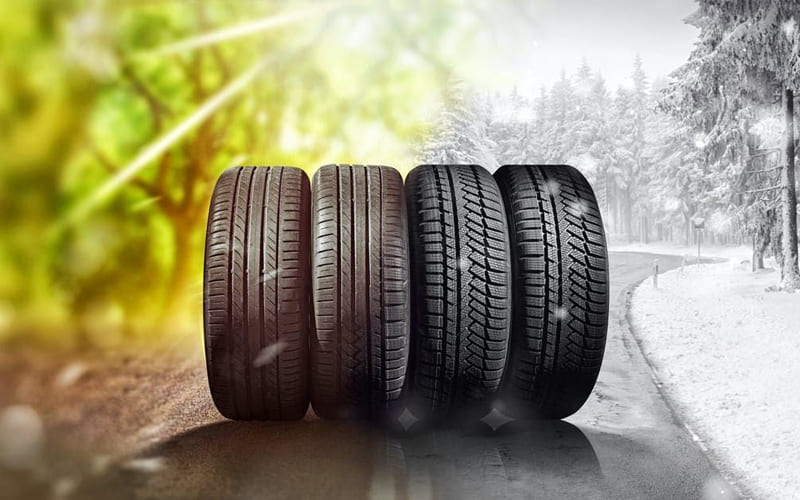Do You Want to Know About Different Types of Tyres? Read More
The part of an automobile that makes contact with the ground that is round and ring-shaped is what we call as tyre, or simply a tyre. Thus, tyres are ideally fitted to rims with pressurised air within. Since the invention of tyres, natural rubber has been the material most frequently used in their manufacture. But modern tyres also employ alternative materials including synthetic rubber, cotton, carbon black, steel wires, and others. Tyres are consequently employed in a wide range of vehicles, from bicycles to aeroplanes.
There are typically two main categories of tyres based on whether they include tubes or not. They are hence referred to as tubes and tubes, respectively. In addition, tyres are of the following main types:
Snow Tyres
Winter tyres have softer constructions because they include more natural rubber. The way the rubber in the tyres interacts with the road surface changes as the temperature rises. However, this affects how well the tyres grip. Summer tyres harden below +7 degrees C, but the specially designed material in winter tyres guarantees suppleness even below +7 degrees C.
Although their name suggests otherwise, they are actually cold weather tyres. They can function effectively on wet, icy, snowy, and cold, dry roads. They are better equipped to grip the road in colder weather because to their softer compound than summer and all-season tyres, which are ideally made of a stronger material.
Their tiny grooves cut through mud, snow, and ice, swiftly distributing water to enhance braking and boost grip. To help with grip on packed snow and to help water disperse so that aquaplaning is less likely, deeper tread grooves catch and hold snow.
Summer Tyres
Summer car tyres Cardiff are generally recommended when the outside temperature is higher than 7 °C. It makes more sense to get summer tyres if you already have winter tyres for temperatures below 7 °C. All-season tyres are more expensive than summer tyres. Using summer tyres has benefits that go beyond cost ones.
You’ll notice the visual distinction between winter and summer tyres when you compare their appearance. Summer tyres have fewer sipes and significantly larger tread blocks. As a result, more rubber will be in contact with the road. Better handling, more stable braking and shorter braking distances are the results.
All-Weather Tyres
With a few exceptions, all-season tyres deliver on their name-brand promise of being functional all year long. The all-season tyre functions with the aid of many sturdy tread blocks. They are often organised in a chevron design. Neither the tread depth is overly shallow, as it is in summer season tyres, nor is it excessively deep, as it is in winter weather tyres.
When comparing winter with all-season tyres, the tyre compound is usually more durable. All-season tyre tread life is however increased by the more strong mixture’s tendency to make those tyres less easily adhere. Its compound is less demanding than that of a summer tyre, nevertheless. The tread life is much less than that of summer tyres as a result.
All-season tyres are less flexible than summer tyres, which makes them less able to grip than all-season tyres. Because of the broad tread blocks, the tyre has fewer edges. These, on the other hand, are appropriate for establishing traction on deeper ice and snow. Therefore, using an all-season tyre in colder climes, on unpaved surfaces, or in rural areas is dangerous. Simply put, because stopping and turning are not as precise as they were with winter tyres, it is no longer intended for usage in deep snow and ice. Similar effects are also caused by overheating; on a warm surface. Summer tyres perform better in terms of manageability and traction.
Run-Flat Tyres
Run-flat Tyres plans to keep running for a short while after a puncture. So let’s say you have a tyre blowout on a cool, dark evening. In that situation, you must be always prepared to drive safely home or to the nearest technician to get your tyre replaced. There is no need for an uncomfortable roadside tyre repair. Run-flat tyres further reduce the likelihood of a potentially disastrous tyre blowout due to their special design.
The run-flat tyres have reinforced sidewalls. An automobile is typically supported by the air in its tyres, which burst when punctured. On the other hand, run-flat tyres include tough rubber components that continue to sustain your car’s weight even after a puncture.
Energy-Saving Tyres
The “rolling resistance” of the road’s tyres must be overcome by the engine or motor of your car when you are driving. Rolling resistance should be as minimal as feasible. This is to maximise economy because it has a significant influence on fuel consumption. As a result, tyre producers developed “energy-saving” tyres. In terms of stopping distances and turning grip, these are typically less dynamic than “regular” tyres, especially in the wet. However, it might significantly increase fuel economy.
Since they consume less energy, energy-saving Car Tyres Cardiff take less fuel to run. Because the engine does not have to work as hard, these tyres utilise less energy to propel the vehicle ahead and consume less gasoline. They do not, however, provide the same level of performance as high-performance tyres, including excellent control and precise steering. However, they increase efficiency and cut down on fuel use.

